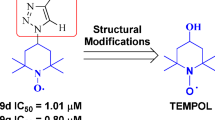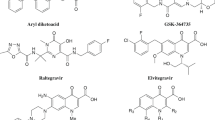Abstract
Nucleoside analogues acyclovir, valaciclovir, and famciclovir are the preferred drugs against human Herpes Simplex Viruses (HSVs). However, the viruses rapidly develop resistance against these analogues which demand safer, more efficient, and nontoxic antiviral agents. We have synthesized two non-nucleoside amide analogues, 2-Oxo-2H-chromene-3-carboxylic acid [2-(pyridin-2-yl methoxy)-phenyl]-amide (HL1) and 2-hydroxy-1-naphthaldehyde-(4-pyridine carboxylic) hydrazone (HL2). The compounds were characterized by different physiochemical methods including elementary analysis, FT-IR, Mass spectra, 1H–NMR; and evaluated for their antiviral efficacy against HSV-1F by Plaque reduction assay. The 50% cytotoxicity (CC50), determined by MTT test, revealed that HL1 (270.4 μg/ml) and HL2 (362.6 μg/ml) are safer, while their antiviral activity (EC50) against HSV-1F was 37.20 μg/ml and 63.4 μg/ml against HL1 and HL2 respectively, compared to the standard antiviral drug Acyclovir (CC50 128.8 ± 3.4; EC50 2.8 ± 0.1). The Selectivity Index (SI) of these two compounds are also promising (4.3 for HL1 and 9.7 for HL2), compared to Acyclovir (49.3). Further study showed that these amide derivatives block the early stage of the HSV-1F life cycle. Additionally, both these amides make the virus inactive, and reduce the number of plaques, when infected Vero cells were exposed to HL1 and HL2 for a short period of time.









Similar content being viewed by others
Data availability
All data generated or analyzed during this study are included in this article.
References
Alizadeh SR, Ebrahimzadeh MA (2021) Antiviral activities of pyridine fused and pyridine containing heterocycles, a review (from 2000 to 2020). MRMC 21:2584–2611. https://doi.org/10.2174/1389557521666210126143558
Azzam RA, Gad NM, Elgemeie GH (2022) Novel thiophene thioglycosides substituted with the benzothiazole moiety: synthesis, characterization, antiviral and anticancer evaluations, and NS3/4A and USP7 enzyme inhibitions. ACS Omega 7:35656–35667. https://doi.org/10.1021/acsomega.2c03444
Bag P, Ojha D, Mukherjee H, Halder UC, Mondal S, Nandi S, Sharon A, Chakrabarti S, Chattopadhyay D (2013) An indole alkaloid from a tribal folklore inhibits immediate early event in HSV-2 infected cells with therapeutic efficacy in vaginally infected mice. PLoS One 8:e77937. https://doi.org/10.1371/journal.pone.0077937
Bag P, Ojha D, Mukherjee H, Halder UC, Mondal S, Biswas A, Sharon A, Van Luc K, Chakraborty S, Das G, Mitra D, Chattopadhyay D (2014) A Dihydropyrido-indole potently inhibits HSV-1 infection by interfering with the viral immediate early transcriptional events. Antiviral Res 105:126–134. https://doi.org/10.1016/j.antiviral.2014.02.007
Chang Y, Cesarman E, Pessin MS et al (1994) Identification of herpesvirus-like DNA sequences in HIV/AIDS-associated Kaposi’s Sarcoma. Science 266:1865–1869. https://doi.org/10.1126/science.7997879
Chen Z, Li P, Hu D et al (2019) Synthesis, antiviral activity, and 3D-QSAR study of novel chalcone derivatives containing malonate and pyridine moieties. Arab J Chem 12:2685–2696. https://doi.org/10.1016/j.arabjc.2015.05.003
Cohen JI (2020) Herpesvirus latency. J Clin Invest 130:3361–3369. https://doi.org/10.1172/JCI136225
Cooper RS, Georgieva ER, Borbat PP et al (2018) Structural basis for membrane anchoring and fusion regulation of the herpes simplex virus Fusogen gB. Nat Struct Mol Biol 25:416–424. https://doi.org/10.1038/s41594-018-0060-6
Cory H, Passarelli S, Szeto J et al (2018) The role of polyphenols in human health and food systems: a mini-review. Front Nutr 5:87. https://doi.org/10.3389/fnut.2018.00087
Cowan FM, French RS, Mayaud P et al (2003) Seroepidemiological study of herpes simplex virus types 1 and 2 in Brazil, Estonia, India, Morocco, and Sri Lanka. Sex Transm Infect 79:286–290. https://doi.org/10.1136/sti.79.4.286
Davison AJ, Eberle R, Ehlers B et al (2009) The order Herpesvirales. Arch Virol 154:171–177. https://doi.org/10.1007/s00705-008-0278-4
De A, Sarkar S, Majee A (2021) Recent advances on heterocyclic compounds with antiviral properties. Chem Heterocycl Comp 57:410–416. https://doi.org/10.1007/s10593-021-02917-3
De S, Kumar SKA, Shah SK et al (2022) Pyridine: the scaffolds with significant clinical diversity. RSC Adv 12:15385–15406. https://doi.org/10.1039/d2ra01571d
Dhiman A, Purohit R (2022) Identification of potential mutational hotspots in serratiopeptidase to address its poor pH tolerance issue. J Biomol Struct Dyn. https://doi.org/10.1080/07391102.2022.2137699
Elion GB (1989) The purine path to chemotherapy. Biosci Rep 9:509–529. https://doi.org/10.1007/BF01119794
Erlich KS (1997) Management of herpes simplex and varicella-zoster virus infections. West J Med 166:211–215
Erukhimovitch V, Bogomolny E, Huleihil M, Huleihel M (2011) Infrared spectral changes identified during different stages of herpes viruses infection in vitro. Analyst 136:2818. https://doi.org/10.1039/c1an15319f
Falanga A, Del Genio V, Kaufman EA et al (2021) Engineering of Janus-Like dendrimers with peptides derived from glycoproteins of herpes simplex virus type 1: toward a versatile and novel antiviral platform. IJMS 22:6488. https://doi.org/10.3390/ijms22126488
Férir G, Petrova MI, Andrei G et al (2013) The lantibiotic peptide labyrinthopeptin A1 demonstrates broad anti-HIV and anti-HSV activity with potential for microbicidal applications. PLoS ONE 8:e64010. https://doi.org/10.1371/journal.pone.0064010
Hamilton HW, Nishiguchi G, Hagen SE et al (2002) Novel Benzthiodiazepinones as antiherpetic agents: SAR improvement of therapeutic index by alterations of the seven-membered ring. Bioorg Med Chem Lett 12:2981–2983. https://doi.org/10.1016/S0960-894X(02)00578-4
Honess RW, Roizman B (1975) Regulation of herpesvirus macromolecular synthesis: sequential transition of polypeptide synthesis requires functional viral polypeptides. Proc Natl Acad Sci USA 2:1276–1280. https://doi.org/10.1073/pnas.72.4.1276
Hull C, Brunton S (2010) The role of topical 5% acyclovir and 1% hydrocortisone cream (Xerese™) in the treatment of recurrent herpes simplex Labialis. Postgrad Med 122:001–006. https://doi.org/10.3810/pgm.2010.09.2216
Ibáñez FJ, Farías MA, Gonzalez-Troncoso MP, Corrales N, Duarte LF, Retamal-Díaz A, González PA (2018) Experimental dissection of the lytic replication cycles of herpes simplex viruses in vitro. Front Microbiol (virology) 9:Article 2406. https://doi.org/10.3389/fmicb.2018.02406
John SF, Aniemeke E, Ha NP et al (2016) Characterization of 2-hydroxy-1-naphthaldehyde isonicotinoyl hydrazone as a novel inhibitor of methionine aminopeptidases from Mycobacterium tuberculosis. Tuberculosis 101:S73–S77. https://doi.org/10.1016/j.tube.2016.09.025
Kan Y, Okabayashi T, Yokota S et al (2012) Imiquimod suppresses propagation of herpes simplex virus 1 by upregulation of cystatin A via the adenosine receptor A1 pathway. J Virol 86:10338–10346. https://doi.org/10.1128/JVI.01196-12
Kather A, Raftery MJ, Devi-Rao G et al (2010) Herpes simplex virus type 1 (HSV-1)-induced apoptosis in human dendritic cells as a result of downregulation of cellular FLICE-inhibitory protein and reduced expression of HSV-1 antiapoptotic latency-associated transcript sequences. J Virol 84:1034–1046. https://doi.org/10.1128/JVI.01409-09
Kawaguchi Y, Tanaka M, Yokoymama A et al (2001) Herpes simplex virus 1 α regulatory protein ICP0 functionally interacts with cellular transcription factor BMAL1. Proc Natl Acad Sci USA 98:1877–1882. https://doi.org/10.1073/pnas.98.4.1877
Kawaii S, Tomono Y, Ogawa K et al (2001) The antiproliferative effect of coumarins on several cancer cell lines. Anticancer Res 21:917–923
Kawase M, Sakagami H, Hashimoto K et al (2003) Structure-cytotoxic activity relationships of simple hydroxylated coumarins. Anticancer Res 23:3243–3246
Krummenacher C, Supekar VM, Whitbeck JC et al (2005) Structure of unliganded HSV gD reveals a mechanism for receptor-mediated activation of virus entry: structure of unliganded HSV gD. EMBO J 24:4144–4153. https://doi.org/10.1038/sj.emboj.7600875
Li T, Zhang J, Pan J et al (2017) Design, synthesis, and antiviral activities of 1,5-benzothiazepine derivatives containing pyridine moiety. Eur J Med Chem 125:657–662. https://doi.org/10.1016/j.ejmech.2016.09.069
Liu G, Wang C, Wang H et al (2019) Antiviral efficiency of a coumarin derivative on spring viremia of carp virus in vivo. Virus Res 268:11–17. https://doi.org/10.1016/j.virusres.2019.05.007
Majewska A, Mlynarczyk-Bonikowska B (2022) 40 years after the registration of acyclovir: Do we need new anti-herpetic drugs? IJMS 23(3):431. https://doi.org/10.3390/ijms23073431
Majnooni MB, Fakhri S, Smeriglio A et al (2019) Antiangiogenic effects of Coumarins against cancer: from chemistry to medicine. Molecules 24:4278. https://doi.org/10.3390/molecules24234278
Mandal J, Das Mahapatra A, Mandal KC, Chattopadhyay D (2021) An extract of Stephania hernandifolia, an ethnomedicinal plant, inhibits Herpes Simplex Virus-1 entry. Archiv Virol 166:2187–2198. https://doi.org/10.1007/s00705-021-05093-z
McGeoch DJ, Gatherer D (2005) Integrating reptilian herpesviruses into the family Herpesviridae. J Virol 79:725–731. https://doi.org/10.1128/JVI.79.2.725-731.2005
Meier AF, Tobler K, Leisi R et al (2021) Herpes simplex virus co-infection facilitates rolling circle replication of the adeno-associated virus genome. PLoS Pathog 17:e1009638. https://doi.org/10.1371/journal.ppat.1009638
Oien NL, Brideau RJ, Hopkins TA et al (2002) Broad-spectrum antiherpes activities of 4-hydroxyquinoline carboxamides, a novel class of herpesvirus polymerase inhibitors. Antimicrob Agents Chemother 46:724–730. https://doi.org/10.1128/AAC.46.3.724-730.2002
Okawa Y, Hideshima T, Steed P et al (2009) SNX-2112, a selective Hsp90 inhibitor, potently inhibits tumor cell growth, angiogenesis, and osteoclastogenesis in multiple myeloma and other hematologic tumours by abrogating signalling via Akt and ERK. Blood 113:846–855. https://doi.org/10.1182/blood-2008-04-151928
Pandey VK, Tusi Z, Tusi S, Joshi M (2012) Synthesis and biological evaluation of some novel 5-[(3-Aralkyl Amido/Imidoalkyl) Phenyl]-1,2,4-Triazolo[3,4-b]-1,3,4-thiadiazines as antiviral agents. ISRN Org Chem 2012:760517. https://doi.org/10.5402/2012/760517
Piret J, Boivin G (2011) Resistance of herpes simplex viruses to nucleoside analogues: mechanisms, prevalence, and management. Antimicrob Agents Chemother 55:459–472. https://doi.org/10.1128/AAC.00615-10
Poole CL, James SH (2018) Antiviral therapies for herpesviruses: current agents and new directions. Clin Ther 40:1282–1298. https://doi.org/10.1016/j.clinthera.2018.07.006
Qin S, Hu X, Lin S et al (2022) Hsp90 inhibitors prevent HSV-1 replication by directly targeting UL42-Hsp90 complex. Front Microbiol 12:797279. https://doi.org/10.3389/fmicb.2021.797279
Razonable RR (2011) Antiviral drugs for viruses other than human immunodeficiency virus. Mayo Clin Proc 86(10):1009–1026. https://doi.org/10.4065/mcp.2011.0309
Reyes M (2003) Acyclovir-resistant genital herpes among persons attending sexually transmitted disease and human immunodeficiency virus clinics. Arch Intern Med 163:76. https://doi.org/10.1001/archinte.163.1.76
Roizman B, Knipe DM, Whitley RJ (2013) Herpes simplex viruses in fields’ virology. In: Knipe DM, Howley P, Griffin DE, Lamb RA, Martin MA, Racaniello VR, Roizman B (eds) Fields’ virology. Wolters Kluwer/Lippincott-Williams and Wilkins, New York, pp 1840–1841
Sepay N, Saha PC, Shahzadi Z et al (2021) A crystallography-based investigation of weak interactions for drug design against COVID-19. Phys Chem Chem Phys 23:7261–7270. https://doi.org/10.1039/D0CP05714B
Sharma B, Bhattacherjee D, Zyryanov GV, Purohit R (2022) An insight from computational approach to explore novel, high-affinity phosphodiesterase 10A inhibitors for neurological disorders. J Biomol Struct Dyn. https://doi.org/10.1080/07391102.2022.2141895
Singh R, Purohit R (2023) Computational analysis of protein-ligand interaction by targeting a cell cycle restrainer. Comput Methods Programs Biomed 231:107367. https://doi.org/10.1016/j.cmpb.2023.107367
Song X, Wang Y, Li F et al (2022) Hsp90 inhibitors inhibit the entry of herpes simplex virus 1 into neuron cells by regulating cofilin-mediated F-actin reorganization. Front Microbiol 12:799890. https://doi.org/10.3389/fmicb.2021.799890
Tahir T, Ashfaq M, Saleem M et al (2021) Pyridine scaffolds, phenols and derivatives of Azo moiety: current therapeutic perspectives. Molecules 26:4872. https://doi.org/10.3390/molecules26164872
Tan BH (2014) Cytomegalovirus treatment. Curr Treat Options Infect Dis 6(3):256–270. https://doi.org/10.1007/s40506-014-0021-5
Valyi-Nagy T, Shukla D, Engelhard HH et al (2007) Latency strategies of alphaherpesviruses: herpes simplex virus and varicella-zoster virus latency in neurons. In: Minarovits J, Gonczol E, Valyi-Nagy T (eds) Latency strategies of herpesviruses. Springer US, Boston, pp 1–36
Wagstaff AJ, Bryson HM (1994) Foscarnet. A reappraisal of its antiviral activity, pharmacokinetic properties and therapeutic use in immunocompromised patients with viral infections. Drugs 48(2):199–226. https://doi.org/10.2165/00003495-199448020-00007
Whitley RJ, Roizman B (2001) Herpes simplex virus infections. The Lancet 357:1513–1518. https://doi.org/10.1016/S0140-6736(00)04638-9
Xiang Y-F, Qian C-W, Xing G-W et al (2012) Anti-herpes simplex virus efficacies of 2-aminobenzamide derivatives as novel HSP90 inhibitors. Bioorg Med Chem Lett 22:4703–4706. https://doi.org/10.1016/j.bmcl.2012.05.079
Acknowledgements
ADM received a fellowship from the Department of Science & Technology (DST)-INSPIRE, Government of India; and a project under DC was financially supported by a research grant from the DST, Government of West Bengal [Memo 362 (Sanc.)/ST/P/S&T/9G-32/2014].
Author information
Authors and Affiliations
Corresponding authors
Ethics declarations
Conflict of interest
No conflict of interest exists, according to the authors.
Ethical statement
This research uses quality control strain of HSV-1 (ATCC), but no human subjects are involved, and thus there is no need to acquire any ethical approval.
Supplementary Information
Below is the link to the electronic supplementary material.
Rights and permissions
Springer Nature or its licensor (e.g. a society or other partner) holds exclusive rights to this article under a publishing agreement with the author(s) or other rightsholder(s); author self-archiving of the accepted manuscript version of this article is solely governed by the terms of such publishing agreement and applicable law.
About this article
Cite this article
Das Mahapatra, A., Patra, C., Sepay, N. et al. Anti-HSV nucleoside and non-nucleoside analogues: spectroscopic characterisation of naphthyl and coumarinyl amides and their mode and mechanism of antiviral action. 3 Biotech 13, 245 (2023). https://doi.org/10.1007/s13205-023-03658-0
Received:
Accepted:
Published:
DOI: https://doi.org/10.1007/s13205-023-03658-0




